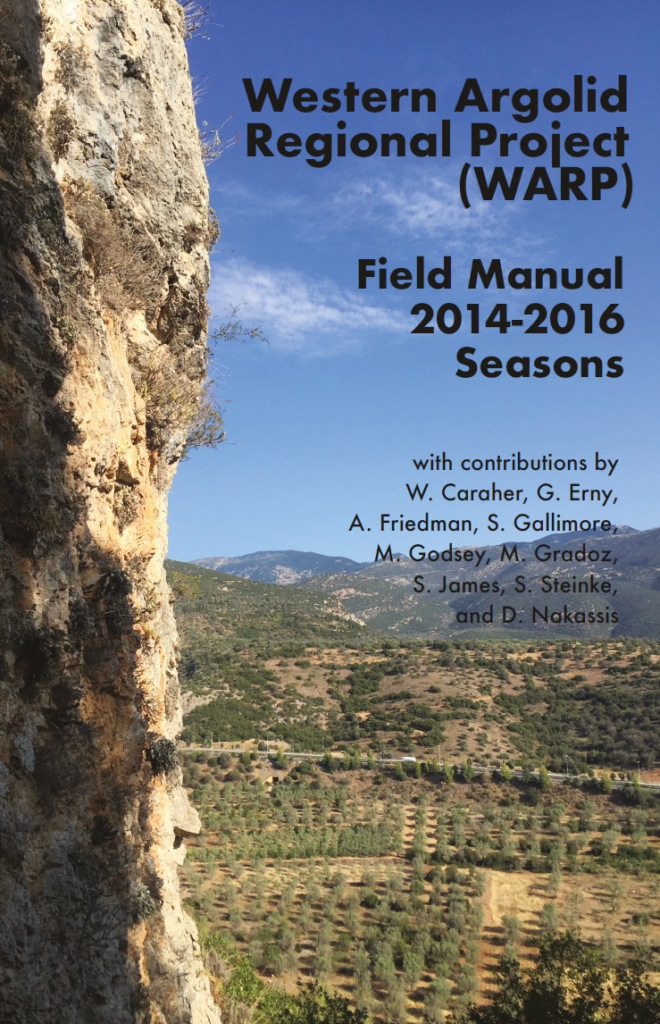This year, bad as it was all around, was pretty good for the WARP team, who produced four publications: three journal articles and our field manual, which we published and archived on the Digital Archaeological Record (tDAR).
In January, Grace Erny & Bill Caraher’s article “The Kingdom of Chelmis: Architecture, Material Culture, and the Modern Landscape of the Western Argolid” came out in the Journal of Field Archaeology. This paper presented the survey’s documentation of the modern settlement of Chelmis, located to the west of the village of Schinochori. Chelmis was effectively abandoned by the time that we worked in the area, but it had been seasonally occupied by agropastoralists from the mountainous village of Frousiouna, probably as early as the late 19th century. We modified our survey methods to meet the specific archaeological contexts of this modern settlement, producing a rich archaeological assemblage. Erny and Caraher argued that while such modern assemblages could be useful analogs to their ancient and medieval counterparts, “the Modern landscape is in some ways incommensurable with the premodern countryside.”
In October, we published our field manual for the 2014-2016 seasons with the Digital Archaeological Record (tDAR), a digital repository for archaeological projects located at the Center for Digital Antiquity, where Rachel Fernandez is a senior digital curator. We wanted to make the manual freely available and archived in the interests of preserving a clear and honest accounting of our field practices and procedures, not only as a resource for other projects who might be interested in them but also for those who are interested in tracking down the developments in the field.
Since then, two papers have come out in journals. The first is an article in the Journal of Greek Archaeology written by Bill Caraher, Scott Gallimore, Dimitri Nakassis, and Sarah James, entitled “Survey and the 7th century in the Western Argolid.” This article emerged from a colloquium at the annual meetings of the Archaeological Institute of America in San Diego in 2019 that was organized by Effie Athanassopoulos, and presents evidence for activity in the 7th century CE in our survey, including work in 2017 that was undertaken in cooperation with Dr. Alcestis Papadimitriou. We concluded that there was broad continuity between earlier centuries of Late Antiquity and the 7th century, as was the case in the nearby Nemea Valley, challenging the view of this period as insecure and radically transformed.
Finally Sarah James just published a paper in HEROM: Journal on Hellenistic and Roman Material Culture which included a thematic section on ‘Minding Gaps in the archaeological record’ organized by Smadar Gabriele, Kristina Winther-Jacobsen and John Lund. The article, entitled “Rediscovering the Late Hellenistic-early Roman Peloponnese: Analyzing transitional ceramic assemblages found on archaeological survey,” demonstrates that traditional periodizations used on archaeological surveys create artificial ‘gaps’ in the ceramic record that can be effectively bridged through careful analysis of surface assemblages (including ‘aoristic analysis’ and other ‘siteless’ analytical tools) and the use of ceramic types that bridge traditional periods, such as late Hellenistic-early Roman. This is especially critical in this transitional period that witnesses the beginning of Roman hegemony in the Peloponnese. Yet James’ analysis reveals that general continuity in the western Argolid from the Classical to early Roman periods, with a steep decline and transformation in the Middle Roman period (ca. 150-400 CE). The paper is an effective demonstration of our survey’s strengths and interests: careful ceramic analysis, siteless survey methods and analyses, and a confrontational attitude towards traditional periodizations and narratives.
We’re currently focusing our attention on longer preliminary publications of our fieldwork, as well as some more focused papers about the survey area, that should be coming out in the next couple of years.

One thought on “2020 in review, WARP edition”